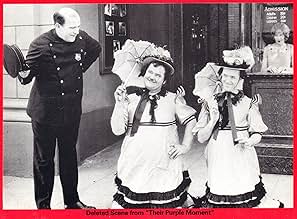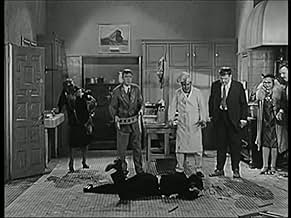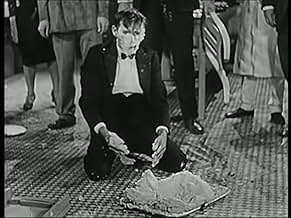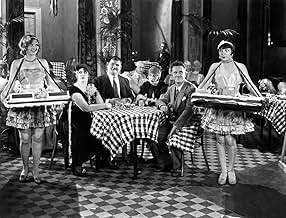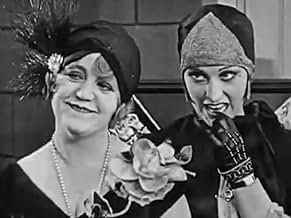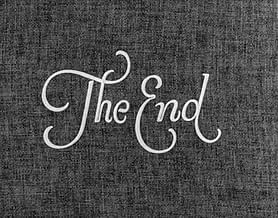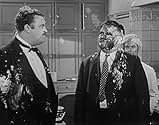NOTE IMDb
6,6/10
919
MA NOTE
Ajouter une intrigue dans votre langueStan and Ollie hold out money from their paychecks from their shrewish wives so they can enjoy a night out on the town... with predictable results.Stan and Ollie hold out money from their paychecks from their shrewish wives so they can enjoy a night out on the town... with predictable results.Stan and Ollie hold out money from their paychecks from their shrewish wives so they can enjoy a night out on the town... with predictable results.
- Réalisation
- Scénario
- Casting principal
Tiny Sandford
- Waiter
- (as S.J. Sandford)
Jimmy Aubrey
- Cook
- (non crédité)
Chet Brandenburg
- Waiter
- (non crédité)
Ed Brandenburg
- Waiter
- (non crédité)
Betty Caldwell
- Nightclub Cigarette Girl
- (non crédité)
Dorothy Coburn
- Hatcheck Girl
- (non crédité)
Edgar Dearing
- Waiter
- (non crédité)
Gracie Doll
- Pink Pub Midget Performer
- (non crédité)
Daisy Earles
- Pink Pub MIdget Performer
- (non crédité)
Harry Earles
- Pink Pub Midget Perfomer
- (non crédité)
Helen Gilmore
- Pink Pub Patron
- (non crédité)
Avis à la une
While I had actually never heard about this 1928 short silent film titled "Their Purple Moment", I needed no persuasion to sit down and watch it, as it was a Stan Laurel and
Oliver Hardy movie after all.
Writers H. M. Walker and Stan Laurel put together a nice script and straightforward storyline. It was pretty much an archetypical Laurel and Hardy movie, for better or worse.
The acting performances in the movie were good, and you know what you are getting from the comedy duo of Stan Laurel and Oliver Hardy. The only familiar faces on the cast list were Stan Laurel and Oliver Hardy, not a surprise really, as I have not been overly much watching movies this old.
Enjoyable and funny, "Their Purple Moment" is definitely one for the fans of Laurel and Hardy.
My rating of directors James Parrott and Fred Guiol's 1928 "Their Purple Moment" lands on a five out of ten stars.
Writers H. M. Walker and Stan Laurel put together a nice script and straightforward storyline. It was pretty much an archetypical Laurel and Hardy movie, for better or worse.
The acting performances in the movie were good, and you know what you are getting from the comedy duo of Stan Laurel and Oliver Hardy. The only familiar faces on the cast list were Stan Laurel and Oliver Hardy, not a surprise really, as I have not been overly much watching movies this old.
Enjoyable and funny, "Their Purple Moment" is definitely one for the fans of Laurel and Hardy.
My rating of directors James Parrott and Fred Guiol's 1928 "Their Purple Moment" lands on a five out of ten stars.
THEIR PURPLE MOMENT
Aspect ratio: 1.33:1
Sound format: Silent
(Black and white - Short film)
Two luckless nightclub revellers (Laurel and Hardy) are unable to pay their bill, provoking violent retribution from a hot-tempered waiter (Tiny Sandford).
Typical L&H scenario, less substantial than some of their best work from this period, but worth a look nonetheless. Stan takes center-stage this time round, caught up in a financial dilemma after holding back part of his wages to fund a night on the town, only to find out - too late! - that his aggrieved wife (Fay Holderness) has replaced his stash with worthless coupons. Some of the prolonged closeups of Laurel as he slowly becomes aware of the unfolding disaster reveal his genius for characterization and mime. 1920's morality is represented by Patsy O'Byrne, playing a hatchet-faced busy-body who takes great joy in alerting L&H's respective spouses (Holderness and Lyle Taho) to their husbands' bad behavior. The ending fizzles, but the movie still has much to recommend it. Directed by James Parrott.
Aspect ratio: 1.33:1
Sound format: Silent
(Black and white - Short film)
Two luckless nightclub revellers (Laurel and Hardy) are unable to pay their bill, provoking violent retribution from a hot-tempered waiter (Tiny Sandford).
Typical L&H scenario, less substantial than some of their best work from this period, but worth a look nonetheless. Stan takes center-stage this time round, caught up in a financial dilemma after holding back part of his wages to fund a night on the town, only to find out - too late! - that his aggrieved wife (Fay Holderness) has replaced his stash with worthless coupons. Some of the prolonged closeups of Laurel as he slowly becomes aware of the unfolding disaster reveal his genius for characterization and mime. 1920's morality is represented by Patsy O'Byrne, playing a hatchet-faced busy-body who takes great joy in alerting L&H's respective spouses (Holderness and Lyle Taho) to their husbands' bad behavior. The ending fizzles, but the movie still has much to recommend it. Directed by James Parrott.
HAVING MADE SOME real progress after their almost accidental teaming as members of what was called THE HAL ROACH ALL-STARS, most of the now familiar L & H situational comedic routines had been established. THEIR PURPLE MOMENT does a lot in defining their eternal struggle with "the Wives."
IN A DRAMATIC SORT of departure from what they had been doing, Stan is called "Mr. Pincher" (for 'penny pincher' we presume); but Ollie retains his own name. This is a kind of throwback to pictures such as PUTTING PANTS ON PHILLIP and DO DETECTIVES THINK?, in which their own names appeared only in the credits.
THERE ARE DEGFINITE symptoms of a maturation of not the LAUREL & HARDY characters; but rather of the HAL ROACH style. The comedies became more and more slow-paced, methodically developed and much more "believable." The Title Cards, most ably written by Roach regular, H.M. Walker, were as witty and clever as ever. But there was none of the going for the laugh outside of the existing story on he scene; as was the practice over at Mack Sennett's KEYSTONE Studios.
THE TYPICAL INTERPLAY that the boys are brought into are typically L & H type of double-edged gag and tit for tat back and forth "Bow & Fiddle", back and forth developing and milking of each gag to its greatest potential. Reliance on Stan's dim-wittedness and Ollie's slow burn were not only appreciated by this point, but rather they were now anticipated.
THE ACTION IN the first three quarters of the picture builds and serves as exposition of both the storyline; as well as the boys themselves. Although they are always the same twosome, there is very little continuity of situations from one short to another.*
IF THERE WOULD be any area of criticism that we could be the ending; which atypically leaves things just a little flat.
BUT SCHULTZ THINKS that this is a minor shortcoming. And Schultz's compadre, this writer, whole heartedly agrees.
NOTE: * In all of their shorts, only the sound comedy two-reelers TIT FOR TAT and THEM THAR HILLS makes mention of the earlier of the two movies and references having met both Charlie Hall and Mae Bush as previous protagonists.
IN A DRAMATIC SORT of departure from what they had been doing, Stan is called "Mr. Pincher" (for 'penny pincher' we presume); but Ollie retains his own name. This is a kind of throwback to pictures such as PUTTING PANTS ON PHILLIP and DO DETECTIVES THINK?, in which their own names appeared only in the credits.
THERE ARE DEGFINITE symptoms of a maturation of not the LAUREL & HARDY characters; but rather of the HAL ROACH style. The comedies became more and more slow-paced, methodically developed and much more "believable." The Title Cards, most ably written by Roach regular, H.M. Walker, were as witty and clever as ever. But there was none of the going for the laugh outside of the existing story on he scene; as was the practice over at Mack Sennett's KEYSTONE Studios.
THE TYPICAL INTERPLAY that the boys are brought into are typically L & H type of double-edged gag and tit for tat back and forth "Bow & Fiddle", back and forth developing and milking of each gag to its greatest potential. Reliance on Stan's dim-wittedness and Ollie's slow burn were not only appreciated by this point, but rather they were now anticipated.
THE ACTION IN the first three quarters of the picture builds and serves as exposition of both the storyline; as well as the boys themselves. Although they are always the same twosome, there is very little continuity of situations from one short to another.*
IF THERE WOULD be any area of criticism that we could be the ending; which atypically leaves things just a little flat.
BUT SCHULTZ THINKS that this is a minor shortcoming. And Schultz's compadre, this writer, whole heartedly agrees.
NOTE: * In all of their shorts, only the sound comedy two-reelers TIT FOR TAT and THEM THAR HILLS makes mention of the earlier of the two movies and references having met both Charlie Hall and Mae Bush as previous protagonists.
The Laurel and Hardy team was now reasonably well established at this time in 1928,but for some reason THEIR PURPLE MOMENT takes one or two steps back;Stan is billed as 'Mr.Pincher'and not Mr.Laurel,and a proposed final scene involving an escape from the night club involving a midget troupe was removed before the film's release,and replaced with a rushed,rather(for L & H)hackneyed final pie throwing sequence.Still,there are some very funny moments,especially with a waiter who keeps on falling into a tray of mashed potatoes;these gags were reworked into the following year's THAT'S MY WIFE(1929).Edgar Kennedy was apparently in these deleted scenes.
For about three-fourths of the way, Their Purple Moment is a sharp, funny Laurel & Hardy comedy, albeit one with a distinctly sour take on married life. This is the first of the L&H domestic comedies, and sets the tone for much of what would follow: Stan and Ollie are each at the mercy of their domineering wives, a pair of hard-bitten shrews who treat them like children, promptly appropriate their paychecks, and deny them any pleasures. (Later on the wives would usually be more nuanced, sometimes even sympathetic, but in this early film they're quite mean.) In what would become a standard plot for the team, this film tells the sad story of what happens when the boys attempt to fool their spouses. Of course, the only question is just how disastrously the situation is going to backfire.
Here, Stan and Ollie tell the wives they're going bowling, then defiantly set out on a spree, under the delusion they've got lots of cash on hand. So when they encounter two attractive young ladies in distress, stuck with a bill they can't pay, naturally, they step in and gallantly offer to treat them to dinner. And it's all downhill from there!
The situation the boys blunder into is a well-constructed comic nightmare that steadily builds in intensity, and the sequence is genuinely suspenseful -- right up to the food-fight finale, which is such a fizzle it practically ruins the whole show. This is surprising, considering that, according to the various books on the team, a much more offbeat and imaginative ending was planned and filmed, but then jettisoned. The original finale utilized the midget troupe of entertainers who perform a floor show in the restaurant. In the earlier version, when the boys discover they have no money to pay their bill, they were to escape by disguising themselves as midgets -- midget women, at that -- and slip away with the troupe. The idea flirts with tastelessness, but it sure seems funnier and more memorable than the finale as it stands now.
Oh well. There are good reasons to watch and enjoy Their Purple Moment nonetheless, among them the famous gag of the uncle's portrait with the hidden pocket, the spirited performance of Patsy O'Byrne as the town gossip, and the always welcome presence of Anita Garvin, here playing a good-time gal who packs a knife. There's also a priceless close-up of Stan, when it dawns on him that he has no money to cover the ever-growing tab: in an extended shot he displays a remarkable range of expressions, from horror to befuddlement, to hope and despair and back again. He was the greatest!
Here, Stan and Ollie tell the wives they're going bowling, then defiantly set out on a spree, under the delusion they've got lots of cash on hand. So when they encounter two attractive young ladies in distress, stuck with a bill they can't pay, naturally, they step in and gallantly offer to treat them to dinner. And it's all downhill from there!
The situation the boys blunder into is a well-constructed comic nightmare that steadily builds in intensity, and the sequence is genuinely suspenseful -- right up to the food-fight finale, which is such a fizzle it practically ruins the whole show. This is surprising, considering that, according to the various books on the team, a much more offbeat and imaginative ending was planned and filmed, but then jettisoned. The original finale utilized the midget troupe of entertainers who perform a floor show in the restaurant. In the earlier version, when the boys discover they have no money to pay their bill, they were to escape by disguising themselves as midgets -- midget women, at that -- and slip away with the troupe. The idea flirts with tastelessness, but it sure seems funnier and more memorable than the finale as it stands now.
Oh well. There are good reasons to watch and enjoy Their Purple Moment nonetheless, among them the famous gag of the uncle's portrait with the hidden pocket, the spirited performance of Patsy O'Byrne as the town gossip, and the always welcome presence of Anita Garvin, here playing a good-time gal who packs a knife. There's also a priceless close-up of Stan, when it dawns on him that he has no money to cover the ever-growing tab: in an extended shot he displays a remarkable range of expressions, from horror to befuddlement, to hope and despair and back again. He was the greatest!
Le saviez-vous
- AnecdotesThe troupe of midgets hired for a deleted scene in the film came from the Al G. Barnes Circus, which was wintering in Los Angeles, at the time. They were paid $50 a day.
- GaffesWhen Stan knocks on the front door and enters the door is completely different in the interior shot. It's the same when Ollie and his wife enter.
- Citations
Title card: [Opening lines] Dedicated to husbands who "hold out" part of their pay envelope on their wives - And live to tell about it...
- ConnexionsFeatured in 4 Clowns (1970)
- Bandes originalesOh, You Beautiful Doll
(1911) (uncredited)
Music by Nat Ayer (as Nat D. Dyer)
Instrumental version in restoration background music
Meilleurs choix
Connectez-vous pour évaluer et suivre la liste de favoris afin de recevoir des recommandations personnalisées
Détails
- Date de sortie
- Pays d’origine
- Site officiel
- Langues
- Aussi connu sous le nom de
- Their Purple Moment
- Lieux de tournage
- Société de production
- Voir plus de crédits d'entreprise sur IMDbPro
- Durée
- 22min
- Couleur
- Mixage
- Rapport de forme
- 1.33 : 1
Contribuer à cette page
Suggérer une modification ou ajouter du contenu manquant

